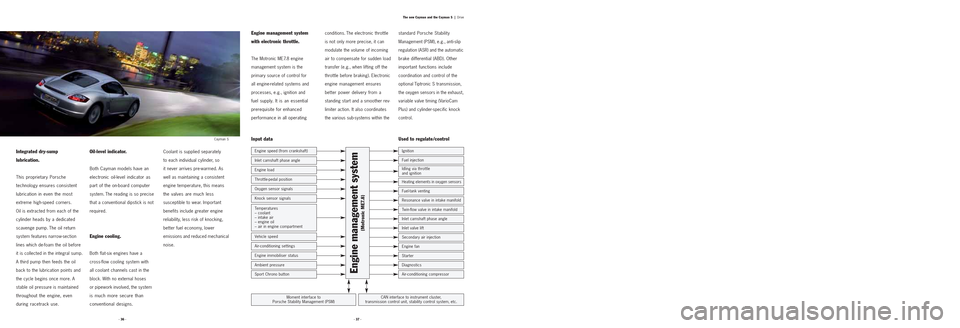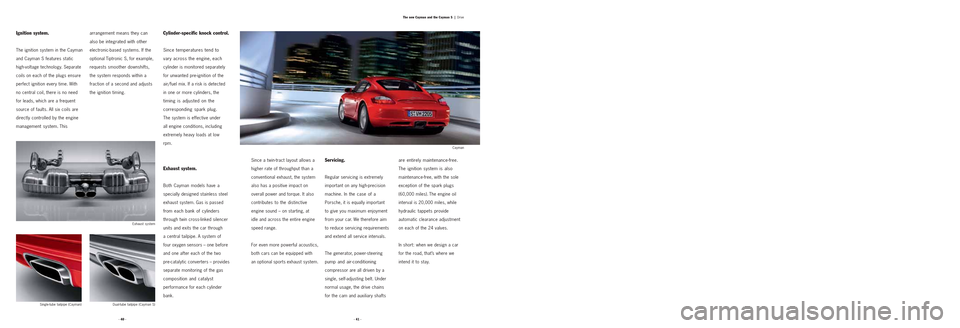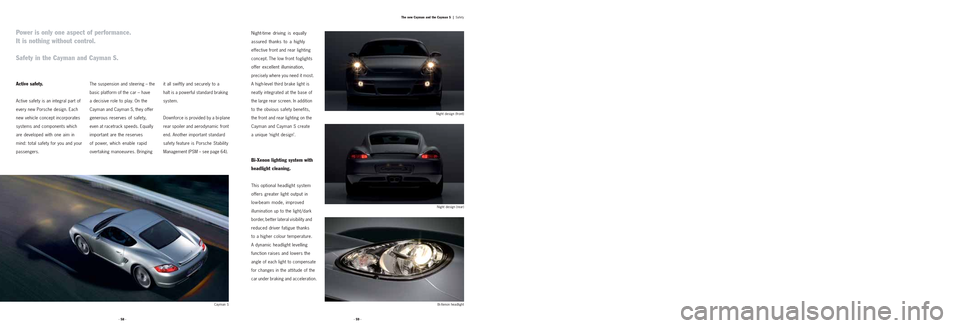oil temperature PORSCHE CAYMAN 2006 1.G Information Manual
[x] Cancel search | Manufacturer: PORSCHE, Model Year: 2006, Model line: CAYMAN, Model: PORSCHE CAYMAN 2006 1.GPages: 61, PDF Size: 2.24 MB
Page 17 of 61

· 37 · · 36 ·The new Cayman and the Cayman S |
Drive
Integrated dry-sump
lubrication.
This proprietary Porsche
technology ensures consistent
lubrication in even the most
extreme high-speed corners.
Oil is extracted from each of the
cylinder heads by a dedicated
scavenge pump. The oil return
system features narrow-section
lines which de-foam the oil before
it is collected in the integral sump.
A third pump then feeds the oil
back to the lubrication points and
the cycle begins once more. A
stable oil pressure is maintained
throughout the engine, even
during racetrack use.
Oil-level indicator.
Both Cayman models have an
electronic oil-level indicator as
part of the on-board computer
system. The reading is so precise
that a conventional dipstick is not
required.
Engine cooling.
Both flat-six engines have a
cross-flow cooling system with
all coolant channels cast in the
block. With no external hoses
or pipework involved, the system
is much more secure than
conventional designs.
Coolant is supplied separately
to each individual cylinder, so
it never arrives pre-warmed. As
well as maintaining a consistent
engine temperature, this means
the valves are much less
susceptible to wear. Important
benefits include greater engine
reliability, less risk of knocking,
better fuel economy, lower
emissions and reduced mechanical
noise.
Engine management system
with electronic throttle.
The Motronic ME7.8 engine
management system is the
primary source of control for
all engine-related systems and
processes, e.g., ignition and
fuel supply. It is an essential
prerequisite for enhanced
performance in all operating
conditions. The electronic throttle
is not only more precise, it can
modulate the volume of incoming
air to compensate for sudden load
transfer (e.g., when lifting off the
throttle before braking). Electronic
engine management ensures
better power delivery from a
standing start and a smoother rev-
limiter action. It also coordinates
the various sub-systems within the
Used to regulate /control
Engine management system
(Motronic ME7.8)
Engine load
Throttle-pedal position
Oxygen sensor signals
Engine speed (from crankshaft)
Inlet camshaft phase angle
Knock sensor signals
Vehicle speed
Air-conditioning settings
Engine immobiliser status
Ambient pressure
Sport Chrono button
Temperatures
– coolant
– intake air
– engine oil
– air in engine compartment
Ignition
Fuel injection
Idling via throttle
and ignition
Heating elements in oxygen sensors
Fuel-tank venting
CAN interface to instrument cluster,
transmission control unit, stability control system, etc.Moment interface to
Porsche Stability Management (PSM)
Input data
Twin-flow valve in intake manifold
Resonance valve in intake manifold
Inlet camshaft phase angle
Inlet valve lift
Secondary air injection
Engine fan
Starter
Diagnostics
Air-conditioning compressor
standard Porsche Stability
Management (PSM), e.g., anti-slip
regulation (ASR) and the automatic
brake differential (ABD). Other
important functions include
coordination and control of the
optional Tiptronic S transmission,
the oxygen sensors in the exhaust,
variable valve timing (VarioCam
Plus) and cylinder-specific knock
control.
Cayman S
Page 19 of 61

· 41 · · 40 ·The new Cayman and the Cayman S |
Drive
Ignition system.
The ignition system in the Cayman
and Cayman S features static
high-voltage technology. Separate
coils on each of the plugs ensure
perfect ignition every time. With
no central coil, there is no need
for leads, which are a frequent
source of faults. All six coils are
directly controlled by the engine
management system. This
Cylinder-specific knock control.
Since temperatures tend to
vary across the engine, each
cylinder is monitored separately
for unwanted pre-ignition of the
air/fuel mix. If a risk is detected
in one or more cylinders, the
timing is adjusted on the
corresponding spark plug.
The system is effective under
all engine conditions, including
extremely heavy loads at low
rpm.
Exhaust system.
Both Cayman models have a
specially designed stainless steel
exhaust system. Gas is passed
from each bank of cylinders
through twin cross-linked silencer
units and exits the car through
a central tailpipe. A system of
four oxygen sensors – one before
and one after each of the two
pre-catalytic converters – provides
separate monitoring of the gas
composition and catalyst
performance for each cylinder
bank.
arrangement means they can
also be integrated with other
electronic-based systems. If the
optional Tiptronic S, for example,
requests smoother downshifts,
the system responds within a
fraction of a second and adjusts
the ignition timing.
Since a twin-tract layout allows a
higher rate of throughput than a
conventional exhaust, the system
also has a positive impact on
overall power and torque. It also
contributes to the distinctive
engine sound – on starting, at
idle and across the entire engine
speed range.
For even more powerful acoustics,
both cars can be equipped with
an optional sports exhaust system.
Servicing.
Regular servicing is extremely
important on any high-precision
machine. In the case of a
Porsche, it is equally important
to give you maximum enjoyment
from your car. We therefore aim
to reduce servicing requirements
and extend all service intervals.
The generator, power-steering
pump and air-conditioning
compressor are all driven by a
single, self-adjusting belt. Under
normal usage, the drive chains
for the cam and auxiliary shafts
are entirely maintenance-free.
The ignition system is also
maintenance-free, with the sole
exception of the spark plugs
(60,000 miles). The engine oil
interval is 20,000 miles, while
hydraulic tappets provide
automatic clearance adjustment
on each of the 24 valves.
In short: when we design a car
for the road, that’s where we
intend it to stay.Exhaust system
Dual-tube tailpipe (Cayman S) Single-tube tailpipe (Cayman)Cayman
Page 28 of 61

· 59 · · 58 ·The new Cayman and the Cayman S |
Safety
Power is only one aspect of performance.
It is nothing without control.
Safety in the Cayman and Cayman S.
Active safety.
Active safety is an integral part of
every new Porsche design. Each
new vehicle concept incorporates
systems and components which
are developed with one aim in
mind: total safety for you and your
passengers.The suspension and steering – the
basic platform of the car – have a decisive role to play. On the
Cayman and Cayman S, they offer
generous reserves of safety,
even at racetrack speeds. Equally
important are the reserves
of power, which enable rapid
overtaking manoeuvres. Bringing
Night-time driving is equally
assured thanks to a highly
effective front and rear lighting
concept. The low front foglights
offer excellent illumination,
precisely where you need it most.
A high-level third brake light is
neatly integrated at the base of
the large rear screen. In addition
to the obvious safety benefits,
the front and rear lighting on the
Cayman and Cayman S create
a unique ‘night design’.
Bi-Xenon lighting system with
headlight cleaning.
This optional headlight system
offers greater light output in
low-beam mode, improved
illumination up to the light/dark
border, better lateral visibility and
reduced driver fatigue thanks
to a higher colour temperature.
A dynamic headlight levelling
function raises and lowers the
angle of each light to compensate
for changes in the attitude of the
car under braking and acceleration.
Night design (rear)
Bi-Xenon headlight Night design (front)
Cayman S
it all swiftly and securely to a
halt is a powerful standard braking
system.
Downforce is provided by a bi-plane
rear spoiler and aerodynamic front
end. Another important standard
safety feature is Porsche Stability
Management (PSM – see page 64).